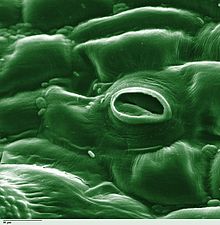**Stomatal Function and Regulation**:
– Stomata in leaves, stems, and organs control gas exchange involving oxygen, carbon dioxide, and water vapor.
– Stomata allow carbon dioxide entry for photosynthesis but result in water vapor loss.
– Stomata open and close in response to environmental factors, with guard cells playing a crucial role.
– Stomatal behavior can be inferred from gas exchange measurements, such as transpiration rate and stomatal conductance.
– Stomatal crypts serve as adaptation to drought and dry climates and can act as vulnerable entry points for pathogens.
**Stomatal Development**:
– Involves three main epidermal cell types leading to the formation of guard cells.
– Stomatal patterning is controlled by signal transduction components like EPF, ERL, and YODA.
– Mutations in genes encoding these factors can alter stomatal development.
– Environmental and hormonal factors influence stomatal development, with light promoting it and auxin repressing it.
– Different plant species exhibit variations in stomatal distribution and size on leaf surfaces.
**Stomatal Types and Classification**:
– Dicot and monocot stomata types include actinocytic, anisocytic, anomocytic, diacytic, hemiparacytic, gramineous, hexacytic, and tetracytic.
– Stomatal anatomy and classification vary among woody plants, dicotyledons, and grasses.
– Evolutionary relations of sunken, covered, and encrypted stomata in dry habitats are observed.
– Stomata are present in most land plants except some, with variations in number and location among species.
– Most angiosperm trees have stomata on their lower leaf surface, with variations in size and frequency.
**Stomatal Response to Environmental Factors and Climate Change**:
– Stomata respond to environmental factors like light intensity, gas concentrations, and CO2 levels.
– Stomatal density and aperture are influenced by environmental factors and CO2 concentration.
– Stomatal response to climate change includes regulation of photosynthesis, water transport, and gas exchange.
– Environmental factors affect stomatal density and aperture, with blue light influencing stomatal response.
– Future adaptations during climate change involve genetic control of stomatal development in response to rising CO2 levels.
**Research on Stomatal Development**:
– Stomatal development is controlled by a MAPKK kinase and regulated by signal transduction components.
– Stomatal development in Arabidopsis is studied for environmental regulation.
– Stomatal anatomy and classification are explored in the context of form, development, and function.
– Stomatal development research includes factors like stomagen positively regulating stomatal density and auxin repressing it.
– Modelling stomatal conductance in response to environmental factors is a focus of research.
In botany, a stoma (pl.: stomata, from Greek στόμα, "mouth"), also called a stomate (pl.: stomates), is a pore found in the epidermis of leaves, stems, and other organs, that controls the rate of gas exchange between the internal air spaces of the leaf and the atmosphere. The pore is bordered by a pair of specialized parenchyma cells known as guard cells that regulate the size of the stomatal opening.



The term is usually used collectively to refer to the entire stomatal complex, consisting of the paired guard cells and the pore itself, which is referred to as the stomatal aperture. Air, containing oxygen, which is used in respiration, and carbon dioxide, which is used in photosynthesis, passes through stomata by gaseous diffusion. Water vapour diffuses through the stomata into the atmosphere as part of a process called transpiration.
Stomata are present in the sporophyte generation of the vast majority of land plants, with the exception of liverworts, as well as some mosses and hornworts. In vascular plants the number, size and distribution of stomata varies widely. Dicotyledons usually have more stomata on the lower surface of the leaves than the upper surface. Monocotyledons such as onion, oat and maize may have about the same number of stomata on both leaf surfaces. In plants with floating leaves, stomata may be found only on the upper epidermis and submerged leaves may lack stomata entirely. Most tree species have stomata only on the lower leaf surface. Leaves with stomata on both the upper and lower leaf surfaces are called amphistomatous leaves; leaves with stomata only on the lower surface are hypostomatous, and leaves with stomata only on the upper surface are epistomatous or hyperstomatous. Size varies across species, with end-to-end lengths ranging from 10 to 80 µm and width ranging from a few to 50 µm.
